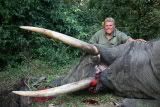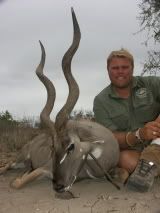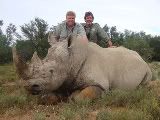

 The Accurate Reloading Forums
The Accurate Reloading Forums  THE ACCURATE RELOADING.COM FORUMS
THE ACCURATE RELOADING.COM FORUMS  Hunting
Hunting  Canadian Hunting
Canadian Hunting  A 'lightbulb' moment?
A 'lightbulb' moment?Go  | New  | Find  | Notify  | Tools  | Reply  |  |
| one of us |
Friday, Jan 26, 2007 Aboriginals admit their hunting may be part of Arctic caribou decline INUVIK, N.W.T. (CP) - Northern aboriginals are acknowledging that how they hunt could be contributing to the rapid decline of the caribou herds central to the soul of the Arctic. A three-day summit on the crisis has recommended that, for the first time in their history, people whose livelihood and culture depend on the iconic animal may have to limit how many caribou they kill. "We have to be disciplined about the way we harvest," said Richard Nerysoo, chief of the Inuvik Dene band. "We have to realize that has to change." Caribou numbers are plummeting throughout the North. Five of seven herds are in decline; a sixth is suspected of shrinking and no information exists on the seventh. The largest of them, the Bathurst herd north of Great Slave Lake, has dropped in the last two decades from nearly half a million animals to 186,000 - a decline of more than 60 per cent. No one knows why. Caribou populations have always fluctuated and some suggest climate change, by altering the delicate timing of spring thaw and calving, is exaggerating the downturn. Others point to increasing industrial activity on the tundra, and the conference recommended protecting calving grounds increasingly being staked for mining. But many also suggested modern hunting methods are crimping the ability of the herds to recover. "It's easier to get caribou these days," said Robert Charlie, head of the Gwich'In Renewable Resources Board. Hunters used to depend on experience to find caribou and on dog teams to get to where they were. Now, herds can be spotted from airplanes and tracked through the Internet. Transportation is easier with roads, trucks and snow machines. The animals are shot with high-powered rifles. Hunters who used to go out a few times a year go out almost monthly. "You have people going out for a couple hours and coming back with caribou," said Charlie. Jimmy Rabesca, a 73-year-old Dogrib elder from Wha Ti, said that ease of access has eroded some of the old reverence for the land and the animals it succors. "We used to hunt animals kindly, respectfully," he said through a translator. "We shot animals because we loved them and we loved the land. Today . . ." he trailed off, shaking his head. Rabesca told the conference he no longer allows his sons to shoot caribou when he and his boys hunt. "They're just playing games out there." Aboriginal hunting, a treaty right, is unregulated and unmonitored. Estimates suggest aboriginals take about 11,000 caribou a year - 10 times the number taken by outfitters and resident hunters, who have already had their quotas cut. Norman Snowshoe of Fort MacPherson said the consequences of using modern equipment and methods haven't sunk in yet. "The change in hunting practices came about fast and people are still adapting to it," he said. "Twenty years ago there were no roads. "We have to bring back some of the principles of conservation that have been taught through the generations of Gwich'In people." Nerysoo agreed that education is necessary. "We have to start teaching young people how to be responsible harvesters, to respect their land." The conference brought together 180 representatives from six territories and provinces, aboriginals, industry representatives, conservation groups, outfitters and sport hunters. But any limitations on harvesting must still be approved by local communities and game councils. For many northern aboriginals in remote communities, hunting caribou is akin to going shopping. Caribou is on the table several times a week and remains a healthy food source that is considerably less expensive than store-bought meat flown in from the south, although it is no longer offered in most Inuvik restaurants. As well, hunting lies at the beating heart of what it means to be Dene. "It's our makeup. It defines us," said Snowshoe. "It's like our language, how we can be identified." That means hunting tags and quotas will be a tough sell. "It's not going to be very popular," Charlie acknowledged. "But we know voluntary compliance doesn't work." Nerysoo said that's why it's so important the Dene take responsibility for protecting the herds. "We can't continue to argue that we are good managers of land if we don't respect the land, and if we don't change the way we do harvest, and if we don't realize that what we're doing today has a consequence for future generations." Charlie said there's already an example of what could happen if that doesn't happen. "We don't want to be like the Plains Indians, when they wiped out the buffalo." © The Canadian Press, 2007 | ||
|
| One of Us |
"Aboriginal hunting, a treaty right, is unregulated and unmonitored. Estimates suggest aboriginals take about 11,000 caribou a year - 10 times the number taken by outfitters and resident hunters, who have already had their quotas cut." Hmm, So much for the natives protecting the land eh! If you have that much to fight for, then you should be fighting. The sentiment that modern day ordinary Canadians do not need firearms for protection is pleasant but unrealistic. To discourage responsible deserving Canadians from possessing firearms for lawful self-defence and other legitimate purposes is to risk sacrificing them at the altar of political correctness." - Alberta Provincial Court Judge Demetrick    | |||
|
One of Us |
Wait...I can almost hear it coming in the distance...."native hunting is not the problem...we are the last conservationists left. Besides, it is our cultural right to slaughter many animals with modern weapons" Lets blame it on global warming, and the "white" interference | |||
|
| Powered by Social Strata |
| Please Wait. Your request is being processed... |
|

Visit our on-line store for AR Memorabilia

